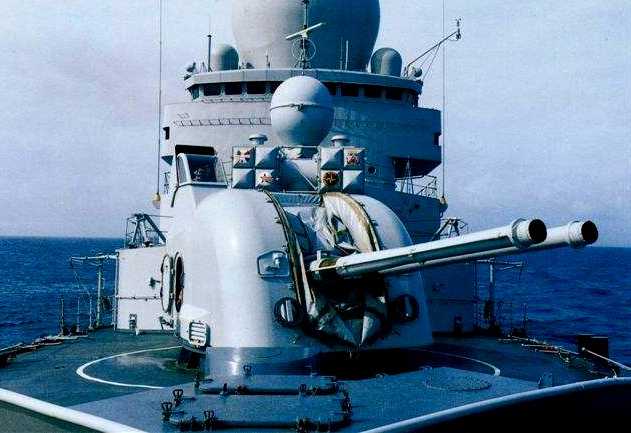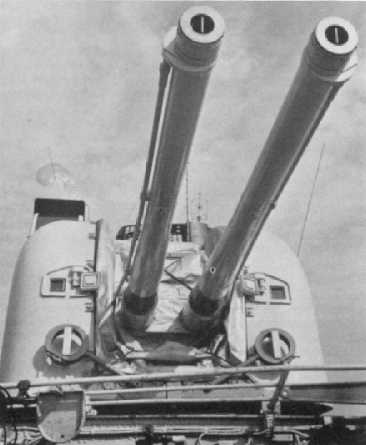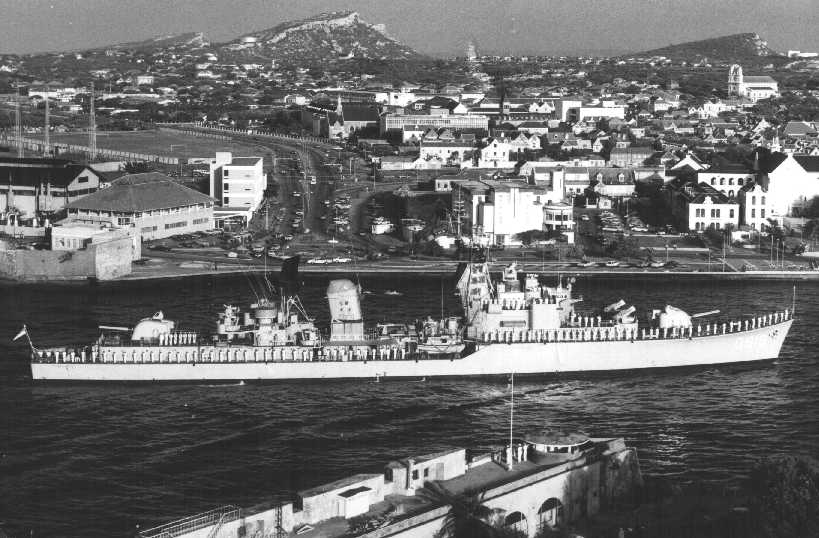A Bofors design, these guns were developed during the 1940s as an intermediate weapon between the 6"/50 (15.2 cm) and the 5.7 cm/60. Used on Swedish, Dutch and Colombian ships.
Employs a pendulum loader and a flick rammer to obtain a high rate of fire. After ramming, the shell separates from the cartridge. Bofors claims that this unusual process decreases barrel wear and also retains the cartridge case firmly in place until the vertical-sliding breechblock has closed. Guns are in a common cradle and barrels have water cooling jackets.
Netherlands guns were assembled by Wilton-Fijenoord.
This mount was considered to be extremely advanced when it first appeared in 1950 and the Swedish Navy was quite happy with this weapon system on their ships. The Netherlands Navy found them to be very reliable once some early training problems were overcome. However, when inspected by the British in 1953, it was rejected as being too heavy, too noisy and not gas- or flash-tight.
| Designation | Sweden: 120 mm/50 (4.7") Model 1950
Netherlands: 120 mm/50 (4.7") Mark 10 |
|---|---|
| Ship Class Used On | Netherlands
Holland, Friesland and Tromp Classes 1 Sweden
Colombia
Peru
|
| Date Of Design | 1944 - 1950 |
| Date In Service | 1950 |
| Gun Weight | N/A |
| Gun Length | 251.5 in (6.387 m) |
| Bore Length | 236.2 in (6.000 m) |
| Rifling Length | N/A |
| Grooves | (36) |
| Lands | N/A |
| Twist | Uniform RH 1 in 27 |
| Chamber Volume | N/A |
| Rate Of Fire | Selectable between 12 and 42 rounds per minute
(42 gives the optimum dispersion) |
- ^The Tromp class frigates were armed with guns and mountings salvaged from HNLMS Gelderland, a Holland class destroyer.
| Type | Fixed |
|---|---|
| Weight of complete round | HE: 97.9 lbs. (44.4 kg)
SAP: 97.9 lbs. (44.4 kg) Illumination: N/A |
| Projectile Types and Weights | HE: 51.8 lbs. (23.5 kg)
SAP: 51.8 lbs. (23.5 kg) Illumination: N/A |
| Bursting Charge | HE: 4.9 lbs. (2.2 kg)
SAP: 0.9 lbs. (0.4 kg) |
| Projectile Length | All: 33.5 in (85 cm) |
| Propellant Charge | 16.1 lbs. (7.3 kg) |
| Muzzle Velocity | 2,789 fps (850 mps) |
| Working Pressure | N/A |
| Approximate Barrel Life | N/A |
| Ammunition stowage per gun | Netherlands: 1,600 rounds
Others: N/A |
| Elevation | Distance |
|---|---|
| 45 degrees | 22,420 yards (20,500 m) |
| AA Ceiling | about 9,800 feet (9,000 m) |
| Designation | Twin Turrets
Netherlands: Holland (2), Friesland (2) and Tromp (1) Sweden: Halland (2) |
|---|---|
| Weight | 114,600 lbs. (52,000 kg) 1a |
| Elevation | -10 / +85 degrees |
| Elevation Rate | 40 degrees per second |
| Train | +140 / -140 degrees maximum |
| Train Rate | 25 degrees per second |
| Gun recoil | 20.5 in (52 cm) 2a |
- ^The mountings originally weighed about 147,700 lbs. (67,000 kg). This was reduced to the above figure by removing the emergency diesel engine, the fuze setting mechanisms and the local fire control equipment.
- ^The maximum, metal to metal recoil distance was 21.7 inches (55 cm).
- The mount was crewed by 12 men of which 5 are in the turret, 2 in the elevator and 5 in the munition stowage.
"Jane's Pocket Book 9: Naval Armament" edited by Denis Archer
"Dutch Naval Weapons of the early 20th Century" by Stefan Boon (unpublished manuscript)
"The Naval Institute Guide to World Naval Weapon Systems 1991/92" by Norman Friedman
---
Special help from Iwan Bos, Helen Peeters, Joakim Wohlfeil and Sjef Pijls
15 October 2007 - Benchmark
21 May 2023 - Converted to HTML 5 format, added additional ammunition and mounting information
11 August 2023 - Added Netherlands and Peruvian classes
28 May 2024 - Corrected class name of Columbian destroyers




